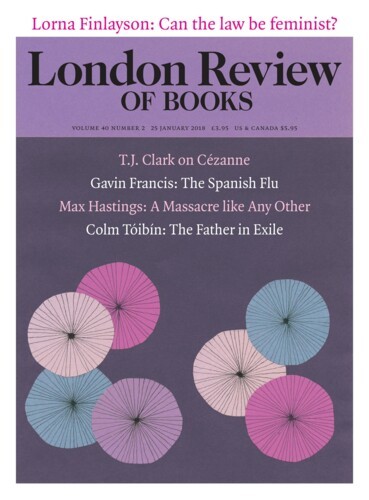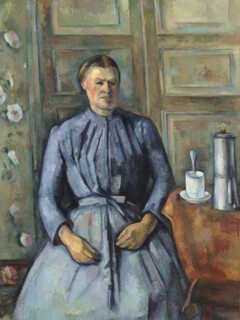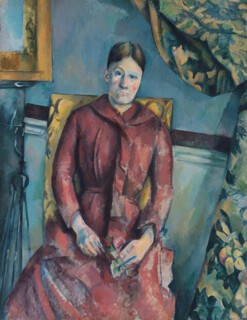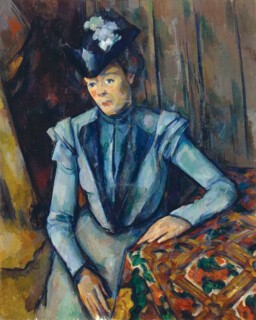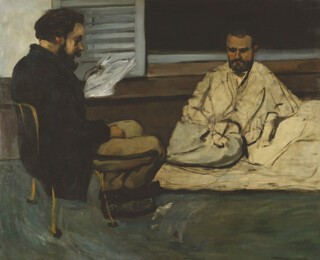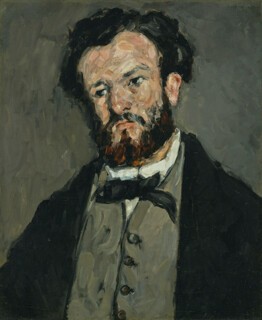Look first at Woman with a Cafetière, who presides over the next to last room of the Cézanne Portraits show, staring down even the saturnine Ambroise Vollard. Then meet the gaze of Madame Cézanne in a Red Dress, infinitely courageous in her alarming throne-room, oppressed – or is it enlivened? – by a glorious Vermeer curtain, a bucking dado, a chairback like a coffin lid, exploding fire tongs, white lightning in the grate, a painting – or is it a mirror? – perched on the chimney breast. It matters that both portraits are of women, and I shall come to that. But it matters just as much that still, more than a century after they were painted, these images so effortlessly keep their distance, resisting our understanding, refusing (as the philosophers say) to ‘come under a description’. In particular they strike me as putting the strange word ‘expression’ to death.
It is not at all clear when the idea took root that Cézanne, when he painted, didn’t care about his subjects as people, as individuals. But for most of the 20th century it was dogma. By the 1950s, when Meyer Schapiro wrote his great book about Cézanne, he knew that the judgment would be on readers’ minds: ‘It has been said that Cézanne painted the heads of his friends and family as if they were apples.’ And further on:
Many writers have remarked on the mask-like character of Cézanne’s portraits. The subject seems to have been reduced to a still life. He does not communicate with us; the features show little expression and the posture tends to be rigid. It is as if the painter has no access to the interior world of the sitter, but can only see him from the outside.
It won’t surprise you to hear that Cézanne’s admirers drew very different conclusions from the two ‘as ifs’ in the sentences just quoted. The Nazi formalist Hans Sedlmayr, unflinching in his regard for Cézanne, thought his art epitomised the loss of a shared ‘world’, which Fascism would put an end to. ‘Precisely because Cézanne confines us wholly to the experience of the eye, he also to some extent shuts off from us the very world that the eye beholds, and makes it impossible for us really to feel our way into it.’ Sedlmayr could not have known Samuel Beckett’s verdict on the artist (it crops up in letters from 1934), but one suspects he would not have been surprised by its reversal of right-wing sympathies:
Cézanne had the sense of his own incommensurability not only with life of such a different order as landscape, but also with life of his own order, even with life – one feels looking at the self-portrait in the Tate – operative in himself.
How far Cézanne had moved from the snapshot puerilities of Manet & Cie when he could understand the dynamic intrusion to be himself.
He seems to have been the first to see landscape [and portraiture, by the look of things] and state it as material of a strictly peculiar order, incommensurable with all human expressions whatsoever.
I think of Woman with a Cafetière as sister to the immured (but undefeated) heroines of Beckett’s late monologues.
John Elderfield, curator of the Portraits show, thinks the first statement of the ‘as if they were apples’ cliché may have been Charles Morice’s in 1905. Morice was the translator of Dostoevsky’s Notes from Underground, so ‘loss of world’ was something he knew well. ‘Cézanne has no more interest in a face than in an apple, and both have no value in his eyes other than their existence as “tones”.’ (The French enforces Cézanne’s coldness with a pun, since ‘valeur’ in painters’ jargon means the effect of a colour in context: hence ‘celui-là comme celle-ci n’ont d’autre valeur à ses yeux que d’être des “valeurs”.’) The lack of interest in faces is thought to be weird, maybe even pathological, and one didn’t have to be a Sedlmayr in the 20th century to drive home the apocalyptic paradox: these are the century’s great paintings, yes, but seemingly because in them attention and estrangement are conditions of one another, and ‘un-aliveness’ – the word is Fritz Novotny’s – rules.
You will have sensed that a lot of this leaves me shaking my head. ‘Aliveness’, in many of the rooms in the Portraits show, is such a reality – such a force and delight – that it takes an effort of the imagination to see how it could have been missed. Elderfield prepares the ground, in one of the show’s first galleries, for a wonderful quote by Rilke (the kind of confession that right-minded art lovers are now supposed to squirm at) talking about another picture of Madame Cézanne: ‘The consciousness of her presence has grown into an exaltation which I perceive even in my sleep; my blood describes her to me.’ Given the choice, I’m with Rilke, but I still want to understand what Beckett meant. Or D.H. Lawrence:
When [Cézanne] said to his models: ‘Be an apple! Be an apple!’ he was uttering the foreword to the fall not only of Jesuits and Christian idealists [it was important to Lawrence that Cézanne ended life in the bosom of the Church] altogether, but to the collapse of our whole way of consciousness, and the substitution of another way. If the human being is going to be primarily an apple, as for Cézanne it was, then you are going to have a new world of men: a world which has very little to say, men that can sit still and just be physically there, and be truly non-moral … Oh, be an apple, and leave out all your thoughts, all your feelings, all your mind and all your personality, which we know all about and find boring beyond endurance. Leave it all out – and be an apple! It’s the appleyness of the portrait of Cézanne’s wife that makes it so permanently interesting: the appleyness, which carries with it also the feeling of knowing the other side as well, the side you don’t see, the hidden side of the moon.
Lawrence, as usual, leads on to difficult places: his pages on Cézanne are outlandish, tremendous (Nietzsche is the argument’s master of ceremonies), and naturally haven’t entered the Cézanne literature. Let me retreat from them (hoping to return), and look instead at the first critical idea these writers signed up to: that ‘Cézanne painted the heads of his friends and family as if they were apples.’
I think the idea misses Cézanne’s point. The critics all seem to know, or think they know, what ‘as if they were apples’ means – what apples are like, and what painting them consists of, technically and temperamentally. But isn’t Cézanne’s art precisely about not knowing? Painting, if you pursue it for a lifetime, may give you a glimpse of the apple and your approach to it; but only if painting starts from, and maybe finishes with, the proposition that an apple is not an ‘object of knowledge’. There are no apples in the two pictures I’ve started with, so fix your attention, if you can (it is part of the Cézanne effect that attention seems to be solicited and then made to feel almost illicit, as if some kind of taboo were being violated), on the coffee cup and spoon, or the flower in Madame Cézanne’s hand, or the folds of the Vermeer curtain. What would it be like to paint a head or face ‘as if’ they were the flower or the curtain? There are no ‘as ifs’ in Cézanne’s universe: nothing is analogous to anything else, the world is made up of unique particulars, and painting sets itself the impossible task of seeing disparity as totality. The spoon in Woman with a Cafetière is upright with its own identity: it has a halo of shadow to keep the rest of reality from contaminating it. The woman’s hands (or her hair with its geological parting) have the same weight and distinctiveness as the spoon. And yet spoon, hair and hands are fitted like cogs or levers into the picture’s naive, elaborate offer of the world-all-at-once: the table so eager to be there for us, pushing its way through the picture plane; the flowers tumbling down the wall, changing colour as they hit the floor; the long central seam of the woman’s dress splitting open under her fist.
So finally I am on the side of the extremists, the Becketts and Sedlmayrs. ‘Loss of world’ is in question in Cézanne’s art, because – Lawrence in particular insists on this – the artist knows that ‘world’ has become, or is fast becoming, a cliché. The more talk of Gemeinschaft, the deeper each individual’s isolation. There seems, to put it baldly, no good alternative to the Sedlmayr view, or at least to its basic assumption. Certainly the idea that Cézanne’s approach to picture-making is essentially technical and ‘objective’, locked in a painter’s preserve (the Charles Morice proposal, which will never die), is useless. It offers false comfort. Cézanne is not in the least ‘detached’ from his sitters, he is relentlessly intimate with them. It is what he proposes intimacy to be that is the terror. He seems to have wanted, maybe to have achieved – with Madame Cézanne, whom he did not live with, with the various Parisian men he distrusted, with the Aixois peasants he paid to sit still – an existence with others that did not depend on an exchange of insides. A behaviour without the pejorative ‘behaviourism’ attached to it. ‘Material of a strictly peculiar order, incommensurable with all human expressions whatsoever.’
There is a cluster of poems by Wallace Stevens, mostly from the 1940s, that seems to me helpful. I think they were written with Cézanne in mind. ‘Less and Less Human, O Savage Spirit’ is central, and especially the poem’s conviction that ‘It is the human that is the alien,/The human that has no cousin in the moon.//It is the human that demands his speech/From beasts or from the incommunicable mass.’ Compare the instructions in ‘Credences of Summer’: ‘Let’s see the very thing and nothing else’; ‘Look at it in its essential barrenness’; ‘Without evasion by a single metaphor.’ (A flower in Cézanne is never a metaphor for the person holding it.) ‘Words, lines, not meanings, not communications,/Dark things without a double.’ (Dark as the seam in the Woman with a Cafetière’s dress.) ‘Any stick of the mass/Of which we are too distantly a part.’
Of course this insight into the world and our place in it is not one we can live with – Stevens knew that full well. If we truly were confronted with an apple with eyes; with teeth; with sound coming out of it, as if from an inwardness, but only ‘as if’ … if that happened, if we saw it, if we came across it, would it be bearable?
So Beckett’s strong reading will not do. It does not get us on terms, I think, with what the square halo of panelling does to Woman with a Cafetière’s head – the way it projects it forward into our space, disclosing and illuminating the woman’s presence, but also encasing her, enshrining her, making her a ‘stick of the mass’. What takes place here is more like a moment in Kafka than Beckett: one of those ends of paragraphs in The Castle where the sheer weirdness of what’s just happened – the improbability of someone impinging on us, giving out signs, following a logic we’ll never reconstruct – is moved on from in the text, quickly, bravely, out of charity, as if it were best to pretend not to notice. In one of his essays Clement Greenberg pays tribute to Cézanne’s unexpected ‘raciness’ as a painter: you can see what he means, even in reproduction, in Madame Cézanne’s hands and flower, or the Monet-type atmospherics of Woman with a Cafetière’s panelling. It is a playfulness or mobility that makes the apple-with-eyes just tolerable. Avert your gaze from Madame’s mummified torso and attend to the earth-quaking room instead.
Hands, in this world without faces, do an enormous amount of work. They are a fulcrum for the bodies – the ‘persons’ – they belong to: around them the body opens, exfoliates, puts on show its basic structure, displays its duality (following the hands left and right) or its multiplicity (since the hands themselves lose edges, flip from concave to convex and back, clench, disintegrate, weigh a ton, unfold into corrugations or diamond facets). They challenge the viewer to see them as part of the body they terminate. Hands are extremities.
Maybe hands are where ‘character’ hides in Cézanne, in the carnal unconscious, however hard an individual or a culture tries to suppress it. Hands can be dreadful – knots of coloured rag, enormous cartridge clips. Sometimes in the Portraits show, though rarely, hands disappear: the ends of arms are cut off by the frame. The effect is always charged, unnerving; but clearly it is not the case that a figure without hands is ipso facto neutralised or disempowered. Madame Cézanne in Blue (1886-87) – hung across the room from Madame in a Red Dress – seems all the stronger for not being digitalised. The same goes for the great portrait Cézanne did of himself late in life, wearing a bonze’s beret. Elderfield rightly snorts at the idea, beloved of the Cézanne literature, that the image bears marks of sickness or fragility. Not having taken the measure of the ‘life’ operative in oneself is, by the look of it here, entirely a source of strength. Hands are irrelevant. (I’m not saying that hands in Cézanne are unfailingly a success. Gustave Geffroy’s are feeble. They sum up a picture in which, for once, a figure is disabled – swallowed and immaterialised – by its surroundings.)
Once upon a time, in the good old days of Walter Benjamin, I thought of writing a book called Paul Cézanne, A Portrait Painter in the Era of High Positivism. Its question would have been: How do human beings offer themselves to ‘portrayal’ in a culture where they understand themselves, and expect others to understand them, as material, ‘individual’, and classed? How, if these are the circumstances, do they attempt to stage their own depiction?
Class is certainly part of the package in Cézanne. It is good to see the room in the Portraits show containing Woman with a Cafetière, Geffroy and Vollard (and a set of long-suffering peasants opposite) given the title ‘The Working Class and the Art World’. The true companion to Woman with a Cafetière is the Hermitage’s Seated Woman in Blue – the painting was in Elderfield’s show earlier in Paris but could not travel to London – where the blue dress is cinched and flounced into a suit of belle époque armour, and the working woman’s stoicism transmutes to Proustian misery. (It is not clear who the sitter was: some say Madame Cézanne again.) Compare the hands. Compare the gazes. Compare the pattern on Seated Woman in Blue’s tablecloth – ‘the green freedom of a cockatoo upon a rug’ – with the earthenware plainness of its peasant companion. Even the backgrounds are classed. Seated Woman in Blue seems to have strayed into a fairytale wood (maybe the forms on the left are rocks in an abandoned quarry Cézanne was fond of). The big bad wolf is not far away.
It is in general a special moment to be looking at Cézanne’s portraits, because after a century and more it becomes clear that the famous ‘inexpressiveness’ of his sitters has to do (not wholly, but indubitably) with their situation in a class society. What Sedlmayr thought was ‘loss of world’ looks more and more like firmly belonging to one, bearing its burden. All five pictures I illustrate speak to that. They are history paintings – so much so, apparently, so deeply and uncomfortably of their time, that it has taken a century for us bourgeois to see it. As early as 1895, the year Cézanne had his first one-man show in Paris, writers sensed in his art a pervasive, implacable sadness. Geffroy talked of ‘une sorte de mélancolie titanesque’. Another critic described ‘une teinte tendrement funèbre, un peu triste et monotone’. (Shades of Baudelaire’s ‘Nous célébrons tous quelque enterrement.’) ‘Il y a sur toutes ces choses vraiment fortes, comme un voile de tristesse. L’art lugubre est peut-être l’art de demain.’ The sadness and tension and confinement in Cézanne, I’ve been proposing, are all bound up with the ultimate fiction, ‘individuality’. How could anyone have missed, one wonders in retrospect, the classed (straight-jacketed) individuality that Madame Cézanne lays claim to – the one-time seamstress and model, encountered at the Atelier Suisse; mother of Cézanne’s illegitimate son; butt of crude jokes from the artist’s bohemian friends? So far I have been calling her Madame Cézanne, which is what she became in 1886, after 17 years in which the ‘liaison’ was kept secret from the artist’s father; but her real name was Hortense Fiquet. After the marriage, and his father’s death a few months later, Cézanne went to live with his mother in the big house out of town. She and her son stayed put in Aix, at 10 bis Cours Sextius.
Cézanne Portraits is a great occasion. Not for the first time we owe a debt to John Elderfield, curator extraordinary, whose choices and hanging and commentary come from a lifetime of looking. ‘Clement Greenberg with a Yorkshire accent’, we used to call him in the 1970s. He still has Greenberg’s gift of cutting through to the non-obvious visual fact; and even the accent has survived (just) the long years at MoMA. The book that accompanies the show is full of matter.* All the show’s wall labels are worth reading. They do not shroud their objects in irrelevant ‘context’, and time and again come up with something new in a painting for us to think about. Here, for example, is Elderfield’s label to a beautiful portrait of Victor Chocquet from 1877:
Victor Chocquet (1821-91), probably the only true friend of Cézanne’s adult life, was also a patron; a great collector who owned over 80 works by Delacroix and eventually 35 by Cézanne. This portrait, one of six of him by Cézanne, was made in the same year as the portraits of Hortense Fiquet on the opposite wall. As with the portrait of Madame Cézanne in a Red Armchair [the one haunting Rilke’s sleep] the figure and setting combine in a surface comprising a multicoloured pattern of blocks of paint. Unlike it – and all but seven or eight of the more than 160 portraits he painted – Cézanne shows us the floor of the room.
This is deceptively quiet. The verdict on friendship in Cézanne’s life is telling, and recurs to mind in front of the Geffroy portrait. The idea that floors are a rarity in Cézanne strikes home: it invites you to look at the floor in question, and wonder if Chocquet’s chair really stands on it. And whether his wavering feet, adrift on the flotsam of carpet, could ever support his weight.
Friendship is a good note to end on. It is important that Cézanne began, as an adolescent and young man, with a close and formidable circle of friends – poets, short-story writers, geologists, novelists, Provençal nationalists in the making – with whom he did not keep up. One of the glories of the Portraits show is the picture of Paul Alexis reading a chapter from a novel, or maybe a piece of criticism (he tried his hand at both), to a crouching, feline Zola. Meyer Schapiro thought that ‘in its breadth and harmony of spacing, [the painting] surpasses Manet.’ (It is rather a pity that in the National Portrait Gallery one cannot get back far enough, in what is essentially a corridor, to see if Schapiro was right.) The dry criss-cross of paint strokes that establishes Zola’s smock and lap in the painting is unparalleled in the 19th century – it alone would tell us that we are in the presence of genius. It could be that Cézanne was looking at Chinese or Japanese calligraphy. What a dialogue between the scrawled smock and the hopeless smeared page of Alexis’s novel!
On the opposite wall in the exhibition hangs a portrait of the poet Antony Valabrègue – it must come from around the same moment as Zola and Alexis, though I’d put it a little later, maybe even 1872. The painting bids a grand farewell to the idea, precious to the young Cézanne, of bringing Courbet back to life – painting as thick and fast as Courbet had done, but making his brutal decisiveness yield gentle, subtle, infinitely qualified results (as Courbet often did). Take the touch of grey in Valabrègue’s hair, for example, or the swirl of soft black running down his waistcoat, making it ruck up a little. Or the line defining his nostril, or all the marks that establish the fragility of his mouth, or the astonishing drawing – but is drawing the right word? – of his eyes in their too shallow sockets. Here’s friendship immortalised.
Why did Cézanne stop painting this way? Why, in particular, did he come to think portraiture had to be done in the manner of Seated Woman in Blue – moving back from its object, painting more hesitantly, obeying the rule of constraint? I have tried to suggest some reasons; but the Valabrègue portrait is there to remind us of how much Cézanne sacrificed, and must have known he was sacrificing, in leaving his first great idiom behind. I suppose it was the decisiveness – the striking through, stroke by stroke, to an equivalent – that came to seem the problem. Of course in the end, in the Valabrègue and other paintings like it, complexity did emerge from the initial definite thing. Uncertainty and vulnerability; guardedness; maybe an indelible suspicion of the world at large – all of it barely bothering to hide behind the boldness, the ‘masculine’ storm of touches, the natty cravat. But what then seems to have happened in the later decades – this is the ultimate message of the Portraits show, I think – is that uncertainty, guardedness and suspicion came to be felt, in practice, in painting, as realities a painting should start from, not reach as its final result. They were the stuff of experience. That was an epistemological verdict, certainly, as Cézanne’s admirers recognised; but also, we now can see, an ethical and sociological one. It was formed in the face of Hortense Fiquet.
Send Letters To:
The Editor
London Review of Books,
28 Little Russell Street
London, WC1A 2HN
letters@lrb.co.uk
Please include name, address, and a telephone number.
